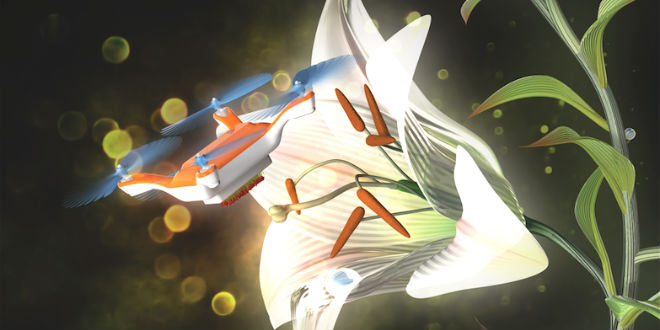

May 23, 2017Could robots replace honeybees as pollinators?
The world’s honeybee population is in a steep decline that science has, so far, been unable to reverse. Some scientists are working on solutions to the culprits — diseases, pests, bee forage availability and pesticides — while others look for alternatives to honeybee pollination.
Three teams of scientists are looking at robotics as a means to reduce dependence on honeybee pollination. Two of them have designed tiny, flying robots, while a third is designing a wheeled robot.
All three devices are prototypes. The aerial projects have already taken wing, while the ground-based model is still in its earliest design phase. Harvard University researchers began their work 10 years ago, while scientists at Japan’s National Institute of Advanced Industrial Science and Technology recently unveiled a wireless aerial pollinator that collects and deposits pollen.
Using a more grounded approach, West Virginia University’s (WVU) multi-disciplinary team is designing an autonomous, wheeled robot that is capable of locating, identifying and pollinating individual blossoms.
Japanese flyer
Announced in Chem, a peer-reviewed journal, the Japanese device consists of a small, wireless drone with a horse-hair belt attached to its underside. It is the only robotic device to have actually pollinated a plant – in this case, a Japanese lily in a lab test.


Eijiro Miyako, the project’s lead contact, coated the robot’s belt with an ionic liquid gel. ILGs remain sticky for a long time in both normal and harsh environments, he said. They are also durable and water resistant.
The compound increased the belt’s usable surface area, which helped it to collect and retain viable pollen amounts during flight. The gel’s wetness and electrostatic properties reduce chances of pollen damage when the belt contacts stamens and pistils.
Miyako described the task of piloting the drone to pollinate flowers as “very hard. I believe that a form of artificial intelligence (AI), GPS and high-resolution cameras would be very useful for the development of future machines,” he said in an email interview.
AI could also improve drone pollinating behavior.
“A swarm of AI robotic bees could determine the shortest path to blossoms and the most efficient means of pollination,” he said.
Harvard’s RoboBee
Pollination is just one application Harvard University lead researcher Robert Wood foresees for a microelectronic robot. He and his team think it might be useful in search-and-rescue operations.


Building the RoboBee was not possible until they invented a new means of manufacture. Called Pop-Up MEMS, pop-up books and origami provided the inspiration. The process uses an elaborate layering and folding process within a frame that assembles robots in a single movement.
Roughly the size of a U.S. quarter, the RoboBee is 2.4 millimeters tall and weighs just under 3.2 ounces. It both flies and swims and can perch upside down on flat surfaces, using static electricity. Next up, the Harvard researchers want to build a “hive” for the bees to recharge their power.
Wood envisions RoboBees deployed in swarms, similar to another of their inventions, Kilobots. Harvard researchers use these tiny, autonomous robots to investigate collective AI and swarm behavior.
Robotic rover
The WVU prototype derives its robotic transport from an autonomous model engineering students built and used to win NASA’s 2016 Sample Return Robot Centennial Challenge. Students designed the autonomous robot to move around a field and retrieve objects using only technology capable of operating in a Martian or lunar environment.


This robot’s function is what its principal investigator calls precision pollination.
“We’re not interested in just blowing air or shaking plants to get them pollinated. We’re interested in dealing with individual flowers,” said Yu Gu, WVU aerospace and mechanical engineering assistant professor.
Gu and his team will mount an array of lidar and cameras to enable a robotic arm to locate individual flowers, determine their viability and apply pollen to healthy blossoms. Similar to radar, lidar uses laser-generated light pulses – instead of sound waves – to detect objects.
WVU will test its pollinator on greenhouse raspberries and blackberries. The ability to test the robot over multiple berry generations within a single year dictated they use an indoor site. This is just the first round of research; further development will occur in subsequent studies.
“We want to show that it is doable first,” Gu said.
In the meantime …
Entomologists at the Danforth Lab at Cornell University believe native bees can shoulder some, and in a few cases, all of an orchard’s pollination requirements. The lab’s research and outreach director, Maria van Dyke, said there are several New York state orchards that no longer rent hives but use native bee pollination instead.
This may be quite important now, since each of the robot models is at least 10 years from commercial release. Harvard’s robot is still tethered to its power source, and the Japanese robot’s guidance system could benefit from the addition of GPS and artificial intelligence.
Gu’s WVU team has not yet completed its planning phase. Once a prototype is constructed, they will do greenhouse test runs and quality-test robotic pollinated fruit against naturally pollinated fruit.
— David Weinstock, FGN correspondent















